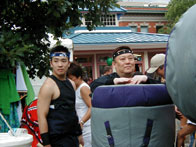“Oya Baka” means “doting parent” in Japanese. Since it’s Mother’s Day today, here’s another from my column:
Black and Yellow
My 3-year-old son wants to be black. All the people he admires _ from Golden Gate Park roller skaters and football stars to break dancers, jazz musicians and even bus drivers _ often happen to be black.
“When I get older, my face is going to get black,” he says proudly.
“What color are you now?” I ask.
“Yellow,” he says in a meek, almost apologetic tone.
“Your daddy is Asian,” I suggest, though he doesn’t appear impressed. “Daddy, you and I are Asian, and we’re proud we’re Asian.” I’ve ben repeating similar propaganda since his infancy.
He looks up with an idea. “Can I pretend my face is black?”
It doesn’t take many years in American society _ 3 years and 3 months to be precise in the case of our Isaku _ to figure out racial myths, which are, in part, based on or are exaggerations of reality.
For the Asian in America, the low cultural energy and absence of positive images make it difficult, if not impossible, for a child to think that we are: cool, creative, sexy, attractive, musical, vivacious, outgoing, etc.
It’s more like we are: academic, responsible, straight, proper, quiet, modest, subdued, etc.
From the above two lists, guess which one Isaku would pick to emulate.
To give an illustration, aside form the pidgin in Hawaii, or the Cantonese-English of the recent Hong Kong immigrants, Asian Americans lack their own vernacular.
The “hip” Asians who talk “street” basically talk black English. They don’t throw in “ne?” or “honto?”
Using Japanese except for names of food (“sushi” is “in” these days) would only destroy their style. And much of Asian American art _ poetry, music, visual art _ remains imitative _ mostly of black or Latin forms, but also of white forms.
Asian Americans have yet to produce an artist on the calibre of Duke Ellington or a media figure with the impact of Prince.
My son recognizes Miles Davis tunes on the radio, strums his plastic guitar wailing “ROCK ‘n’ roooooll music, if you wanna dance with me,” and beats on his drums, claiming he’s Elvin Jones. (And all this despite the unusual fact that we do have Asian American friends who play music.)
I point out Brue Lee posters, whenever they are encountered, which isn’t that often these days. But I’m being unreasonable to expect a martial artist-actor, no matter how dramatic and handsome, to be relevant to a 3 year old. Many years lie ahead before he’ll be taken to those violent films.
With the intention of alleviating _ but perhaps ultimately intensifying _ my son’s identity crisis, I’ve been taking him to a Congolese dance class for children his age. Being of a contrary nature, anyway, he refused to participate. Then I made the worst parental mistake. I praised another student, a little girl, who was performing fantastically, and he muttered with a horrible hatred in his voice, “She’s black.”
“Don’t say anything like that,” I hissed, controlling an urge to strangle him while praying that no one else had overheard. “It doesn’t matter what you are _ black or Asian. We’re all friends.”
We had never taught him to be conscious of race that so-and-so was this race while someone else was something else.
But after the class, I had to lecture to my son, “J.J. is black, and Seiji is black, and they’re your friends. Wain is black and Dorothy is black …” I felt like an idiot. But that was the only way he’d have understood.
“But I like black, mama,” he protested, tears brimming in his eyes.
I wished that we didn’t have to live in world that divided people by the color of skin. I wished that skin color didn’t matter to Isaku, someone so young and innocent, but it did, and I was powerless to change it.
